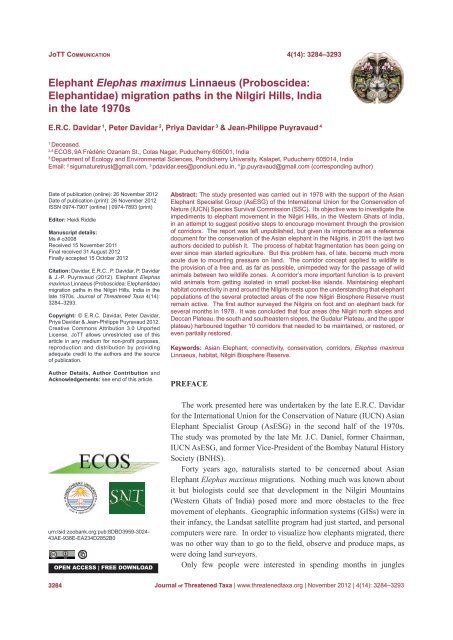View - Journal of Threatened Taxa
View - Journal of Threatened Taxa
View - Journal of Threatened Taxa
You also want an ePaper? Increase the reach of your titles
YUMPU automatically turns print PDFs into web optimized ePapers that Google loves.
JoTT Co m m u n ic a t i o n 4(14): 3284–3293Elephant Elephas maximus Linnaeus (Proboscidea:Elephantidae) migration paths in the Nilgiri Hills, Indiain the late 1970sE.R.C. Davidar 1 , Peter Davidar 2 , Priya Davidar 3 & Jean-Philippe Puyravaud 41Deceased.2,4ECOS, 9A Frédéric Ozanam St., Colas Nagar, Puducherry 605001, India3Department <strong>of</strong> Ecology and Environmental Sciences, Pondicherry University, Kalapet, Puducherry 605014, IndiaEmail: 2 sigurnaturetrust@gmail.com, 3 pdavidar.ees@pondiuni.edu.in, 4 jp.puyravaud@gmail.com (corresponding author)Date <strong>of</strong> publication (online): 26 November 2012Date <strong>of</strong> publication (print): 26 November 2012ISSN 0974-7907 (online) | 0974-7893 (print)Editor: Heidi RiddleManuscript details:Ms # o3008Received 15 November 2011Final received 31 August 2012Finally accepted 15 October 2012Citation: Davidar, E.R.C., P. Davidar, P. Davidar& J.-P. Puyravaud (2012). Elephant Elephasmaximus Linnaeus (Proboscidea: Elephantidae)migration paths in the Nilgiri Hills, India in thelate 1970s. <strong>Journal</strong> <strong>of</strong> <strong>Threatened</strong> <strong>Taxa</strong> 4(14):3284–3293.Copyright: © E.R.C. Davidar, Peter Davidar,Priya Davidar & Jean-Philippe Puyravaud 2012.Creative Commons Attribution 3.0 UnportedLicense. JoTT allows unrestricted use <strong>of</strong> thisarticle in any medium for non-pr<strong>of</strong>it purposes,reproduction and distribution by providingadequate credit to the authors and the source<strong>of</strong> publication.Author Details, Author Contribution andAcknowledgements: see end <strong>of</strong> this article.Abstract: The study presented was carried out in 1978 with the support <strong>of</strong> the AsianElephant Specialist Group (AsESG) <strong>of</strong> the International Union for the Conservation <strong>of</strong>Nature (IUCN) Species Survival Commission (SSC). Its objective was to investigate theimpediments to elephant movement in the Nilgiri Hills, in the Western Ghats <strong>of</strong> India,in an attempt to suggest positive steps to encourage movement through the provision<strong>of</strong> corridors. The report was left unpublished, but given its importance as a referencedocument for the conservation <strong>of</strong> the Asian elephant in the Nilgiris, in 2011 the last twoauthors decided to publish it. The process <strong>of</strong> habitat fragmentation has been going onever since man started agriculture. But this problem has, <strong>of</strong> late, become much moreacute due to mounting pressure on land. The corridor concept applied to wildlife isthe provision <strong>of</strong> a free and, as far as possible, unimpeded way for the passage <strong>of</strong> wildanimals between two wildlife zones. A corridor’s more important function is to preventwild animals from getting isolated in small pocket-like islands. Maintaining elephanthabitat connectivity in and around the Nilgiris rests upon the understanding that elephantpopulations <strong>of</strong> the several protected areas <strong>of</strong> the now Nilgiri Biosphere Reserve mustremain active. The first author surveyed the Nilgiris on foot and on elephant back forseveral months in 1978. It was concluded that four areas (the Nilgiri north slopes andDeccan Plateau, the south and southeastern slopes, the Gudalur Plateau, and the upperplateau) harboured together 10 corridors that needed to be maintained, or restored, oreven partially restored.Keywords: Asian Elephant, connectivity, conservation, corridors, Elephas maximusLinnaeus, habitat, Nilgiri Biosphere Reserve.Prefaceurn:lsid:zoobank.org:pub:8DBD3959-3024-43AE-938E-EA234D2852B0OPEN ACCESS | FREE DOWNLOADThe work presented here was undertaken by the late E.R.C. Davidarfor the International Union for the Conservation <strong>of</strong> Nature (IUCN) AsianElephant Specialist Group (AsESG) in the second half <strong>of</strong> the 1970s.The study was promoted by the late Mr. J.C. Daniel, former Chairman,IUCN AsESG, and former Vice-President <strong>of</strong> the Bombay Natural HistorySociety (BNHS).Forty years ago, naturalists started to be concerned about AsianElephant Elephas maximus migrations. Nothing much was known aboutit but biologists could see that development in the Nilgiri Mountains(Western Ghats <strong>of</strong> India) posed more and more obstacles to the freemovement <strong>of</strong> elephants. Geographic information systems (GISs) were intheir infancy, the Landsat satellite program had just started, and personalcomputers were rare. In order to visualize how elephants migrated, therewas no other way than to go to the field, observe and produce maps, aswere doing land surveyors.Only few people were interested in spending months in jungles3284<strong>Journal</strong> <strong>of</strong> <strong>Threatened</strong> <strong>Taxa</strong> | www.threatenedtaxa.org | November 2012 | 4(14): 3284–3293

















